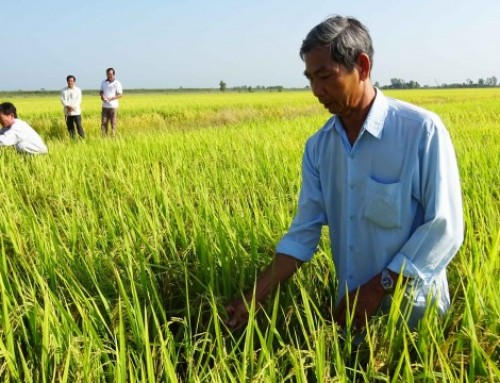Integrated pest management in rice demonstrates promising results in Vietnam
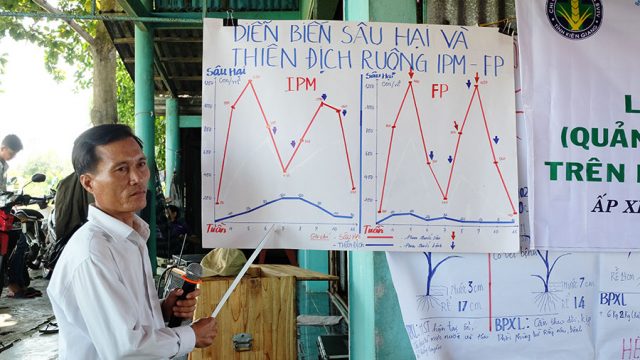
Demo plots using integrated pest management (IPM) practice in Dong Yen Commune in Kien Giang Province, Vietnam showed rice crops grew better while farmers saved more from a reduction of chemical use.
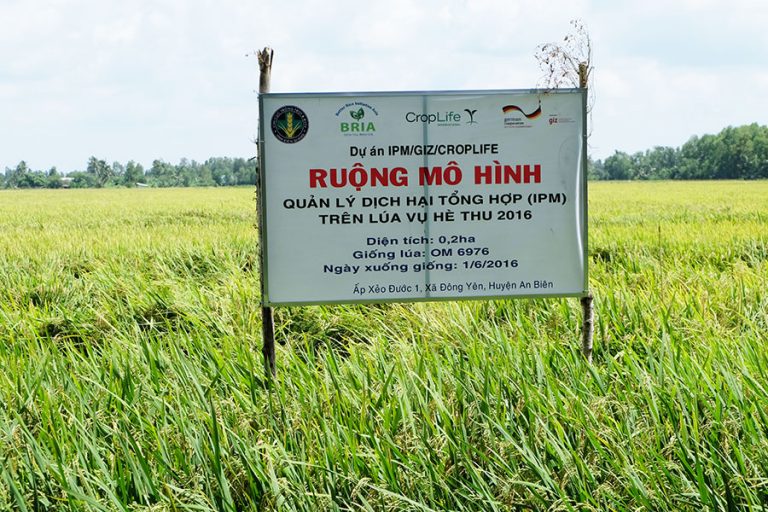
Farmers in Dong Yen Commune grew rice in a demo field using integrated pest management in a comparision with a farmer’s convention practice.
The summer growing season in Vietnam recently brought about 1000 farmers in three provinces of Hau Giang, Dong Thap and Kien Giang to a six-month GIZ/ Croplife International’s IPM training for safe and sustainable agriculture environment.
Set up by GIZ and co-funded by Croplife International, the programme expects additional 4000 farmers to be trained indirectly through “farmer to farmer” knowledge exchange with an involvement of specialists of the Plant Protection Department (PPD) at provincial and district levels, extension services and farmer organizations. The programme runs from July 2015 to December 2017.
Thirty-four groups of farmers in the three provinces of the Mekong Delta met on a weekly basis during March to September 2016 to exchange experiences on IPM and plant protection related issues through a specific training module guided by PPD technical staff as the Master Trainers. For demonstration purposes, each farmer group established two experimental fields: one with IPM measures and another with farmer’s conventional plant protections.
At the end of the planting season, the lesson learnt was collected and summarized and the results of both IPM demonstration and farmers’ practice fields were analyzed.
Sample results in Dong Yen commune in Kien Giang Province are presented as below.
Organizing farmer group
- Farmers: Thirty active farmers (28 males and 2 females) who were interested in new agricultural production technologies were selected to participate as a directly trained farmer group. The group consisted of a leader and a deputy and was divided into four smaller sub-groups for discussion on farmer field school activities.
- Master trainers: Two master trainers who earlier participated in Training of Trainers on IPM at the Southern Regional Plant Protection Center (SRPPC) took care of the group.
Activities
Every week two master trainers organized IPM training classes including field survey, rice eco-system analysis, evaluating the development of rice crop as well as emerging pests to prepare suitable control decisions. The training classes were organized through the 12-week of the rice growing season.
Sowing preparation:
- Land preparation: Clean the field, leveling, GAS (Golden Apple Snail) control.
- Sowing preparation: Seeds were soaked for 24 hours and put in heap for 36 hours before sowing.
- Two DAS (Day After Sowing) spraying pre-germinate herbicide
Monitoring Indicators
Rice crop was monitored during 21, 35, 49 and 63 DAS. In each field, four plots were selected 50x50cm) and data was taken from these four plots.
- Plant height: Count from soil surface to top of the rice plant (tip of the leaf or panicle). Five plants per plot were randomly selected for data.
- Number of tillers: Count number of tillers with at least three leafs.
- Root length: Three plants were selected in each plot. Roots were cleaned and measured (unit: cm)
- The population of main pests and their natural enemies were counted in both IPM demonstration and farmer practice fields.
- Disease level was evaluated both in demonstration and farmer practice field.
Results
Seed
Both IPM demonstration and farmer practice fields used OM6976 rice variety.
- IP demo: 120 kg/ha
- Farmer practice: 170 kg/ha
IPM demonstration is saving 50kg of certified seed per ha compared to farmer practice. (In comparison with usual farmers’ practice, the seed rate was reduced at the demonstration plot. Achieving the same yield of 7.5 t/ha, this cultivation practice reduced the production costs significantly and contributes to a higher farmers’ income.
Fertilizer
Table 1. Applied fertilizer for IPM demo and FP field (kg/ha)
| DAS | IPM Demo | Farmer Practice | ||||
| Urea | DAP | Kali | Urea | DAP | Kali | |
| 15 | 40 | 70 | – | 50 | 70 | – |
| 25 | 50 | 50 | – | 70 | 60 | – |
| 42 | 70 | – | 40 | 70 | – | 50 |
| Total | 160 | 120 | 40 | 190 | 130 | 50 |
| Nutrients: | 95,2 N – 55,2P2O5 –24 K2O | 110.4 N – 59,8 P2O5 – 30 K2O | ||||
According to Table 1, nutrients in IPM demo were more balanced and suitable for the demand of the crops in each growing stage. The seed rate in IPM demo was lower than farmer practice (FP), and the applied fertilizer was also lower. IPM demo saved 15.2 kg N, 4.6 kg P2O5, and 6 kg K2O per ha compared to farmer practice.
Pesticide application
Observation from pesticide application (see Table 2):
IPM demo: Low seed rate and balanced fertilization according to crop stages facilitated a healthy crop from the beginning of the season. Moreover, insecticide was not applied during the first 40 days, and as a result, natural enemies were conserved. Consequently, the application of insecticide was not necessary during the whole rice growing season. For disease control, four applications were used, including two applications for sheath rot at 56 and 63 DAS (appearance of disease), and two preventive applications for neck blast and grain discoloration at flowering stage.
| Time
(DAS) |
Pest/disease | IPM demo applications | FP applications | ||
| Name | Dosage | Name | Dosage | ||
| 3 | Weed | Sirus 10WG | 0,2 | Sirus 10WG | 0,2 |
| 7 | Weed | Co 2,4D 500DD | 0,2 | Co 2,4D 500DD | 0,2 |
| 42 | BPH | – | Chess 50WG | 0,3 | |
| 47 | Sheath rot | Validacin 5L
Anvil 5sc |
0,7 L
1 L |
Validacin 5L
Anvil 5sc |
0,7 L
1 L |
| 59 | Sheath rot | Validacin 5L
Anvil 5sc |
0,7 L
1 L |
Validacin 5L
Anvil 5sc |
0,7 L
1 L |
| 63 | Leaf folder
Blast grain discoloration BLB |
Tilt Super 300 EC Visen 20SC |
0,3 | Indosuper 150SC
Chubeca 1.8 SL
|
0,3
0,3 |
| 73 | BPH | — | Chess 50WG | 0,3 | |
| 77 | Rice Blast
Grain discoloration |
Tilt Super 300 EC | 0,3 | Tilt Super 300 EC | 0,3 |
Table 2: Pesticide application, name, dosage, and time
Farmer practice: High seed rate and excessive nitrogen application made pest and disease developing faster. Moreover, the farmer relied on chemicals for insect control especially in the early crop stage. As a result, the population of natural enemies decreased, and insect pest population developed faster. Finally, in the farmer practice field insecticides were applied three times and fungicides were applied four times for combating pests and diseases.
Result: IPM demonstration reduced three applications of insecticides compared to farmer practice.
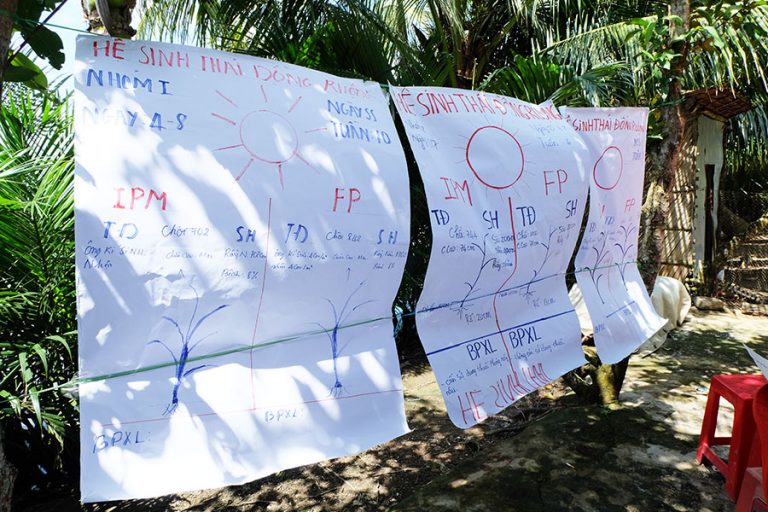
Farmers in Dong Yen Commune learn about integrated pest managment for safe and sustainable agriculture environment.
Agronomic Indicators
Number of Tillers (tillers/m2)
In FP field, a higher seed rate was applied so they get a higher number of tillers. Tiller density reached the highest number at 35 DAS. Weaker tillers which could not compete for nutrients and light with others became ineffective and had low yields. At the end, the number of panicles in IPM demo and FP was nearly similar. It was found that the low seed rate did not affect the rice yield but contributed to saving farm inputs and expenses.
Root length (cm)
IPM demo applied better land preparation and water management at the early crop stage; as a result, the root system developed better, so root length is higher than FP, which protects the plant from lodging.
Pest and Diseases Indicators
* Brown Plant Hoppers (BPH)
Insect Pest and Natural Enemies’ Population in IPM Demo

Insect Pest and Natural Enemies’ Population in FP

IPM demo: Low seed rate, no insecticide application, balanced fertilization, protection of natural enemies; as a result, BPH population could not develop.
FP field: High seed rate and high nitrogen application facilitated BPH population development. At 42 DAS, a new generation of BPH hatched. As a result, farmers needed to spray against BPH. At 63 DAS, leaf folder appeared so the farmer needed to apply insecticide for controlling the leaf folder. At 70 DAS a second generation of BPH hatched and the farmer had to spray once more against BPH. In total, three insecticide applications were used in the FP field.
Conclusion: Growing a healthy crop and conserve natural enemies would prevent a BPH outbreak in the late crop stage. As a result, reducing chemical applications contribute to lower farm input expenses, avoid pesticide residues and protect the environment.
* Natural Enemies
Table 3: Natural enemies’ (NE) population in IPM demo and FP field; Units/m2
| Day after sowing | Spider | Water bug | Mirid bug | |||
| IPM | FP | IPM | FP | IPM | FP | |
| 28 DAS | 1 | 3 | — | — | 2 | 5 |
| 35 DAS | 10 | 7 | 5 | 8 | 9 | 9 |
| 42 DAS | 16 | 16 | 10 | 12 | 12 | 15 |
| 49 DAS | 20 | 11 | 17 | 9 | 20 | 4 |
| 56 DAS | 24 | 10 | 35 | 10 | 23 | 9 |
| 63 DAS | 23 | 12 | 25 | 8 | 21 | 4 |
| 70 DAS | 17 | 8 | 20 | 4 | 19 | 4 |
| 77 DAS | 18 | 3 | — | — | 15 | 5 |
| 84 DAS | 12 | 5 | — | — | 10 | 7 |
Observation: In the early crop stage up to 42 DAS NE population in IPM demo and FP field was similar. However, at 42 DAS farmer applied insecticide to control BPH and, consequently, the NE population reduced significantly. In IPM demo insecticide was not applied; as a result, the NE population was higher.
Diseases
During the rice eco system analysis sheath rot disease was found in both IPM demo and FP demo so two chemical applications were used.
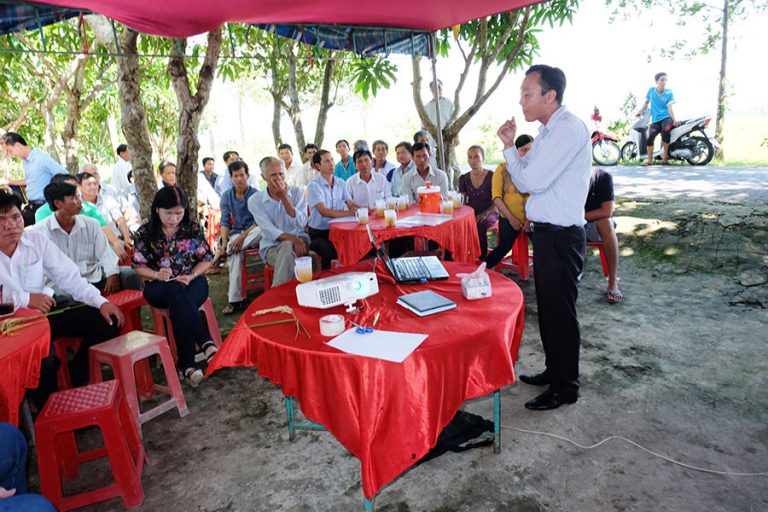
Thirty farmers in Dong Yen met on a weekly basis to exchang experiences on plan protection and intergrated pest managment practices.
Yield calculation
Table 4: Projected Yield of IPM demo and FP
| TT | Field | Panicle/m2 | Fertile spikelet/ panicle | Grain weight
1000 (g) |
Yield (kg/ha) |
| 1 | IPM Demo | 555 | 52 | 26 | 7.50 |
| 2 | FP | 613 | 47 | 26 | 7.50 |
According to Table 4, IPM demo had a lower number of panicles compared to FP field. The reason is IPM demo used a lower seed rate, which leads to a lower number of tillers and panicles. However, in IPM demo there was a higher number of fertile spikelet per panicle than in the farmer practice field. Under good farming practice, a balanced fertilization and pest and disease control, and a higher number of fertile spikelet was recorded. As a result, IPM demo and FP field expect the same yield.
Gross margin calculation (see Table 5)
– IPM demo expected the same yield as FP. The revenue from both fields would be 36,750,000 VND/ha. Gross margin of IPM demo would be 25,780,000 VND/ha (1028 EUR), and FP field would be 23,709,000 VND/ha (945 EUR).
– Farm expense of IPM demo was 10,970,000 VND/ha, and of FP field is 13,041,000 VND/ha, so IPM demo saved 2,071,000 VND/ha compared to FP (83 EUR).
– Conclusion: At the IPM demo, the gross margin is 2,071,000 VND/ha higher than at the FP.
Table 5: Farm Expenses and Gross Margin Calculation
| No | Description | IPM demo | FP | Diff. | ||||
| Amount | Cost | Amount | Cost | |||||
| 1 | Rice seed | 120 Kg | 1.560.000 | 170Kg | 2.210.000 | +650.000 | ||
| 2 | Land preparation | 1 ha | 1.000.000 | 1 ha | 1.000.000 | – | ||
| 3 | Fertilizer | 320 Kg | 2.750.000 | 370 Kg | 3.158.000 | +408.000 | ||
| 4 | Pesticide | 1 ha | 1.560.000 | 1 ha | 2.363.000 | +803.000 | ||
| 5 | Other cost | 1 ha | 2.000.000 | 1 ha | 2.210.000 | +210.000 | ||
| 6 | Harvesting | 1 ha | 2.000.000 | 1 ha | 2.000.000 | – | ||
| 7 | Farm expense | 10.970.000 | 13.041.000 | +2.071.000 | ||||
| 8 | Yield (kg/ha) | 7.5 | 7.5 | |||||
| Paddy price | 4.900 VND/kg | |||||||
| 9 | Revenue (VND) | 36.750.000 | 36.750.000 | |||||
| 10 | Grossmargin (VND) | 25.780.000 | 23.709.000 | +2.071.000 | ||||
Conclusions
- Directly trained farmers improved their knowledge in farm management, especially safe and sustainable agriculture, reduced chemical applications, and conserved NE. As the result, environment pollution was reduced, farmers’ health was less affected, and product quality was enhanced.
- Leaf cutting of 25 per cent and 50 per cent of leafs in 21, 42 and 63 DAS showed that leaf folder may not damage the rice yield. Farmers were convinced on avoiding defoliator pesticide applications.
- IPM application in the early crop stage will reduce the number of spraying.
Vietnam continues to face a challenge of an overuse and misuse of pesticides with a need to optimize pesticide treatments and eliminate unnecessary pesticide applications. Integrated Pest Management (IPM) is widely considered as most appropriate to prevent crop losses through insects, diseases, weeds, rodents and others. Relevant stakeholders in crop protection including farmers and various associates in the pesticide supply chain have a common interest in maintaining the sustainability of effective pest management including the responsible and safe use of pesticides.
[wpdm_package id=’8223′]
By ASEAN Sustainable Agrifood Systems Vietnam team





